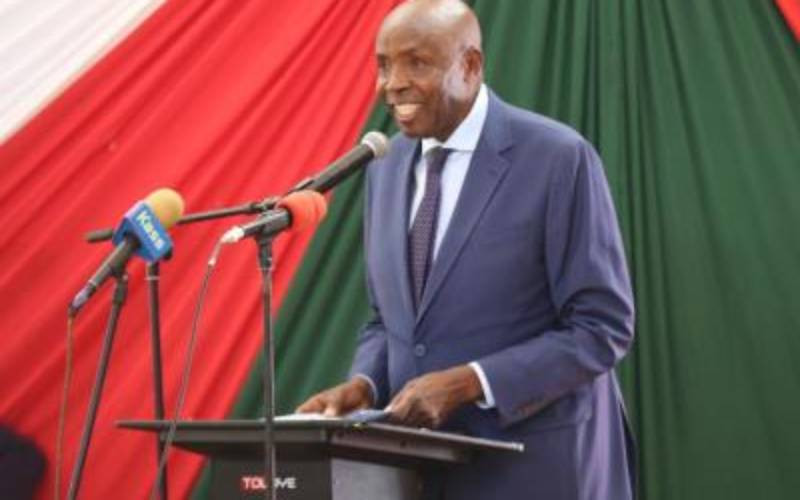A new report has explained why many candidates who sat the 2016 Kenya Certificate of Secondary Education (KCSE) examinations failed.
Of the 574,125 candidates who sat the examinations, some 295,463 students scored grade D and below. Of these, 33,399 scored E, 149,929 attained grade D– while 112,135 posted grade D. Only 141 candidates scored the coveted grade A with some 4,645 candidates scoring grade A– while 10,975 attained B+.
An investigation into the national examination administration process reveals that the Kenya National Examination Council (Knec) overlooked many steps, leading to the ‘abnormal results’.
A document prepared by a teachers union – after extensive consultation – says the critical process of moderating the results was not done. It further reveals that a uniform grading system was adopted for all subjects against the normal practice.
The Kenya National Union of Teachers’ (Knut) document dubbed “The Glaring Shortcomings” also finds that students were “deliberately down marked” and alleges that marking was done with predetermined outcome.
Major flaws
In a blow-by-blow explanation, the Knut document explains the marking process and unearths major flaws that it says would have resulted in a normal examination curve if adopted.
First, the report says the examiners did not have the chance to interact with the questions before going to the marking centres.
“Normally, the examiners before reporting for marking are supposed to interact with the paper they are to mark. No paper was left in school for anybody to interact with,” says the report.
It further finds that the marking scheme was not subjected to discussion and adoption by examiners before marking commenced.
“The chief examiner obtains dummies from schools at random. These dummies are used to coordinate the marking scheme. The chief examiner and assistant chief examiner normally agree on the marks to award each dummy,” reads the report.
“After they have settled on the marks, the assistant chief examiner then proceeds to coordinate the marking scheme with team leaders until the same mark is arrived at with the team leaders. The team leaders then do the same with the examiners under their jurisdiction. Once the marking scheme has been agreed on, it is adopted and marking starts,” reads the report.
Knut claims the marking scheme was not subjected to these processes. “It was imposed on the markers,” said Secretary General Wilson Sossion.
The Knut report further explains that once marking starts, the team leaders are expected to sample 10 per cent of the marked scripts from their teams to counter check the marks and caution on any deviations.
In addition to this, the union says the assistant chief examiner is also expected to pick another 10 per cent of the scripts from the team leaders and marks.
Stay informed. Subscribe to our newsletter
“The chief examiner also picks 10 per cent from the assistant chief examiner and also cautions on any deviations,” reads the report.
The union’s report finds that the above processes were not strictly followed.
“The marking scheme was made deliberately for students to fail. Even in cases where questions had earlier been repeated from previous KCSE past papers, the marking differed sharply,” reads the report.
Second, the report also finds flaws during filling of marks in the mark sheet.
“The examiners are supposed to fill in the mark sheet provided by Knec. The filling is normally counter checked in the same manner the marking is counter checked upwards. But this time round, from the examiners it was taken straight to Knec for feeding in the system,” says the six-page report.
Third, the document says after examinations marking is over in December, the markers often go back around January to mark stray scripts. Stray scripts are papers, which were never marked for certain logistical reasons such as mix up in packaging.
“This time round, it was not clear when stray scripts were marked,” reads the report.
Fourth, the Knut report claims a critical step called the award ceremony, which is presided over by the chief examiner of every examination paper, was not followed is the moderation exercise.
“They look at the performance in their papers across the country and then propose on grading system. This is meant to normalise the grades.”
Yesterday, Sossion said the uniform grading system adopted means that the award ceremony was overlooked.
“You cannot use a grading system for mathematics on English. Performance varies and therefore it must be moderated,” he said.
The report finds that the step of normalising grades was missing. “There was no standardisation and moderation done at all. It is also evident that the examinations were hurriedly marked and released,” the report says.
Fifth, apart from the massive errors in the computation of marks, the report says it is clear that no cross-checking was done.
The report findings say that there was no verification, validation and cites poor conversion of marks.
Extensive probe
“Raw marks were graded and the grading system used was not known to all. This explains the many As in the humanities and hardly any in English and Sciences that led to that poor performance amongst boys compared to girls,” reads the report.
Knut says the report was prepared after thorough and extensive investigations and consultations within and outside government.
“The expectation is that the ministry of education will come in handy to address the concerns to disarray public speculations of malice as well as addressing the immediate consequences of mass failure in the results,” reads the report.
Justifying their calls for immediate recall of the 2016 results, Knut cites a number of consequences, including undue = of the 2016 class in the job market.
“...students who are to be admitted to international universities will automatically miss their slots due to poor performance in English, which is the key subject to consider in their admission.”
The report also says that schools that have been performing well will be labeled as cheats without evidence being put forward.
 The Standard Group Plc is a
multi-media organization with investments in media platforms spanning newspaper
print operations, television, radio broadcasting, digital and online services. The
Standard Group is recognized as a leading multi-media house in Kenya with a key
influence in matters of national and international interest.
The Standard Group Plc is a
multi-media organization with investments in media platforms spanning newspaper
print operations, television, radio broadcasting, digital and online services. The
Standard Group is recognized as a leading multi-media house in Kenya with a key
influence in matters of national and international interest.
 The Standard Group Plc is a
multi-media organization with investments in media platforms spanning newspaper
print operations, television, radio broadcasting, digital and online services. The
Standard Group is recognized as a leading multi-media house in Kenya with a key
influence in matters of national and international interest.
The Standard Group Plc is a
multi-media organization with investments in media platforms spanning newspaper
print operations, television, radio broadcasting, digital and online services. The
Standard Group is recognized as a leading multi-media house in Kenya with a key
influence in matters of national and international interest.










